Figure 1.

Involvement of endocytic components in systemic metabolism in the postprandial (feeding) period. After a meal, circulating blood glucose levels rise, leading to a massive entry of glucose into pancreatic β‐cells via the glucose transporter GLUT2, which causes the release of insulin into the blood stream. The cell surface amounts of GLUT2 are maintained constant via recycling of GLUT2. Adipocytes, the main cell type of adipose tissue, sense the increase in circulating insulin levels resulting in an induction of p‐AKT‐dependent signaling cascades that favor the fusion of GLUT4 storage vesicles with the plasma membrane, increasing the surface expression of GLUT4. When GLUT4 is translocated at the cell surface, glucose will enter into adipocytes and be stored as triglycerides within the lipid droplets. Concomitantly, insulin acts on the main liver cells, hepatocytes, by inducing a cascade of signaling events downstream of the insulin receptor. These signals will restructure the genomic program of the hepatocytes towards anabolic processes, either storing glucose that enters the cells in a concentration‐dependent manner via GLUT2 into glycogen, or utilizing the glucose for glycolysis. In addition to controlling glucose levels, hepatocytes also participate in the regulation of cholesterol levels. To achieve this function, circulating low‐density lipoprotein cholesterol (LDL‐C) is taken up by the hepatocytes and sent to lysosomes, where the digested cholesterol will be extracted via the Niemann‐Pick proteins into the cytosol. Cytosolic cholesterol can then be used either for incorporation into membranes or for bile acid production. Examples of endocytic components that play a role in these metabolic processes are labeled in red. EE, early endosomes; ERC, endosomal recycling compartment; GSVs, GLUT4 storage vesicles; ISGs, insulin secretory vesicles; LYS, lysosome; TG, triglycerides; IR, insulin receptor; LDLR, LDL receptor; NPC, Niemann‐Pick protein
